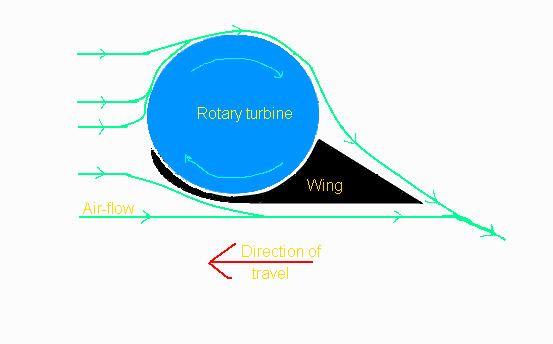 | ||
The FanWing is an aircraft configuration in which a horizontal-axis cross-flow fan is used in close conjunction with a fixed wing. The fan forces airflow over the fixed surface to provide both lift and forward thrust.
Contents
Description
The fans extend the full span of the wing from root to end plates and approximately 50% of the wing's chord, from a little to the rear of the leading edge to a wedge-like fairing that forms the trailing edge.
A cylindrical radial turbine resembling the blades of a cylinder mower is embedded in the upper surface of the wing with its axis parallel to the wingspan, leaving approximately 2/3 of the turbine's outer diameter exposed with the remainder being enclosed in a trough formed at the leading edge and terminating in a comma-shaped wedge.
The radial turbine increases the velocity of the airflow over the wing's upper surface independently of the forward motion of the aircraft, so that the fan wing can achieve useful lift at forward speeds lower than the stalling speed for a conventional wing.
Limitations
Various remote-controlled scale models demonstrated controlled flight but there are negatives compared with normal fixed-wing flying:
Development
The FanWing idea was conceived in 1997 by Patrick Peebles, an American based in the UK, who formed the FanWing Company and applied for patents in countries where aircraft are manufactured. In July 2005 the company announced the first FanWing aircraft was in development in the United Kingdom, having undergone wind tunnel tests and powered model flights. It won SMART awards in 2002 and 2003 and the UK government contributed to development funding.
In May 2007 the developers announced a prototype STOL urban surveillance drone would be built. They also announced that a two-seat technology demonstrator was to be flown at AirVenture in Oshkosh, Wisconsin in 2013, but that doesn't appear to have happened. A tail-plane has since been added to the models which has increased the minimum forward speed.
As of 2014 support for wind tunnel tests of a 1.5 meter wing section was being provided through EU sources including €783,000 through the German Aerospace Center.
A freight application has been suggested that would permit STOL operations at night in developed areas.
